Related Research Articles

Capoeira is a Brazilian martial art from Bahia, that combines elements of dance, acrobatics, and music. It was practiced by enslaved Africans in Brazil at the beginning of the 16th century. It is known for its acrobatic and complex maneuvers, often involving hands on the ground and inverted kicks. It emphasizes flowing movements rather than fixed stances; the ginga, a rocking step, is usually the focal point of the technique. The most widely accepted origin of the word capoeira comes from the Tupi words ka'a ("forest") paũ ("round"), referring to the areas of low vegetation in the Brazilian interior where fugitive slaves would hide. A practitioner of the art is called a capoeirista.

The güiro is a Latin American percussion instrument consisting of an open-ended, hollow gourd with parallel notches cut in one side. It is played by rubbing a stick or tines along the notches to produce a ratchet sound.
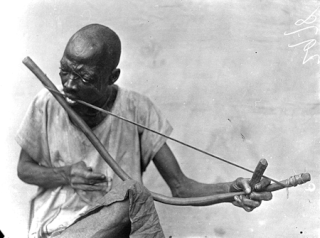
The musical bow is a simple string instrument used by a number of South African peoples, which is also found in the Americas via slave trade. It consists of a flexible, usually wooden, stick 1.5 to 10 feet long, and strung end to end with a taut cord, usually metal. It can be played with the hands or a wooden stick or branch. It is uncertain if the musical bow developed from the hunting bow, though the San or Bushmen people of the Kalahari Desert do convert their hunting bows to musical use.
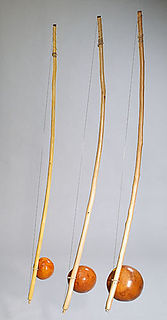
The berimbau is a single-string percussion instrument, a musical bow, originally from Africa, that is now commonly used in Brazil.
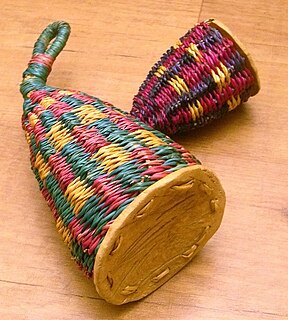
A caxixi is a percussion instrument consisting of a closed basket with a flat bottom filled with seeds or other small particles. The round bottom is traditionally cut from a dried gourd. The caxixi is an indirectly struck idiophone. Like the maraca, it is sounded by shaking. Variations in sound are produced by varying the angle at which the caxixi is shaken, determining whether the contents strike the reed basket or the hard bottom.

Calabash, also known as bottle gourd, white-flowered gourd, long melon, birdhouse gourd, New Guinea bean and Tasmania bean, is a vine grown for its fruit. It can be either harvested young to be consumed as a vegetable, or harvested mature to be dried and used as a utensil, container, or a musical instrument. When it is fresh, the fruit has a light green smooth skin and white flesh.

In capoeira, music sets the rhythm, the style of play, and the energy of a game. In its most traditional setting, there are three main styles of song that weave together the structure of the capoeira roda. The roda represents the most strict and traditional format for capoeira and is ideally suited for an introduction and discussion of the music. Though we may consider the music traditional, because it has been passed orally from one to the next until the early - mid 20th century when songs and rhythms began to be notated and recorded, there is no record of to what extent and exactly how the music has evolved over time. Capoeira's Brazilian heritage plays a heavy role in the way capoeira is perceived by its practitioners and understood at a subconscious level. It is a common feature of many Brazilian ethnic groups, for instance, as well as others throughout the world, that music is not so much a form of personal entertainment as it is a medium to bring about group cohesion and dynamic. Music in the context of capoeira is used to create a sacred space through both the physical act of forming a circle and an aural space that is believed to connect to the spirit world. This deeper religious significance exists more as a social memory to most capoeira groups, but is generally understood as evidenced in the use of ngoma drums, the berimbau whose earlier forms were used in rituals in Africa and the diaspora in speaking with ancestors, the ever-present term axé which signifies life force, the invocation of both Afro-Brazilian and Catholic spirituality, and certain semi-ritualized movements used in Capoeira Angola that bring "spiritual protection". The instruments are:
up to 3 berimbaus
up to 2 pandeiros
1 agogô
1 reco-reco
1 atabaque or conga
Not every roda will contain all these instruments. Mestre Bimba, for instance, preferred only one berimbau and two pandeiros in his rodas, but there will always be at least one berimbau in any roda.

The shekere is a West African percussion instrument consisting of a dried gourd with beads or cowries woven into a net covering the gourd. The instrument is common in West African and Latin American folkloric traditions as well as some of the popular music styles. In performance it is shaken and/or hit against the hands.

The hulusi, also known as the cucurbit flute and the gourd flute is a free reed wind instrument from China, Vietnam and the Shan State and by the indigenous people of Assam. It is held vertically and has three bamboo pipes that pass through a Calabash gourd wind chest; the center pipe has finger holes and the outer two are typically drone pipes. It is not uncommon for a hulusi to have only one drone pipe while the second outer pipe is merely ornamental. The drone pipe has a finger hole which allows it to be stopped. Advanced configurations have keyed finger holes similar to a clarinet or oboe, which can greatly extend the range of the hulusi to several octaves.

The afoxé is an Afro Brazilian musical instrument composed of a gourd (cabaça) wrapped in a net in which beads or small plastic balls are threaded. The instrument is shaken to produce its musical noise.
Traditional Vietnamese musical instruments are the musical instruments used in the traditional and classical musics of Vietnam. They comprise a wide range of string, wind, and percussion instruments, used by both the Viet (Kinh) majority as well as the nation's ethnic minorities.
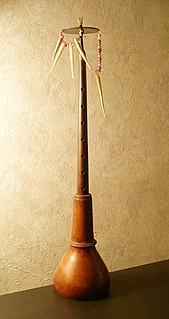
The kèn bầu is one of several types of kèn, a double reed wind instrument used in the traditional music of Vietnam. It is similar in construction and sound to the Chinese suona and the Korean taepyeongso. It comes in various sizes and is a primary instrument of the music of the former royal court music of Huế.

Crescentia cujete, commonly known as the calabash tree, is a species of flowering plant that is grown in Africa, Central America, South America, the West Indies and extreme southern Florida. It is the national tree of St. Lucia. It is a dicotyledonous plant with simple leaves, which are alternate or in fascicles (clusters) on short shoots. It is naturalized in India. The tree shares its common name with that of the vine calabash, or bottle gourd.
The malunga is a single-stringed musical bow played by the Siddi of India, who are the descendants of East African immigrants. It produces two tones, an octave apart, and the knuckle of the hand supporting the instrument may be pressed against the string to vary the pitch. It is struck with a stick and, as with the berimbau of Brazil, the hand holding the stick also holds a rattle. The malunga has a gourd resonator which amplifies the instrument's sound. The placement of this rattle along the string also varies the pitch produced by the Malunga.

The gourd mouth organ is a free reed mouth organ played across East and Southeast Asia. It consists of a gourd wind chest with several bamboo or bronze pipes inserted on top of it, the numbers of pipes differing from region to region.
The eleaotua is a musical bow played in Guam, also spelled eluaotuas, eleaotuchan, and elimau-tuyan. This gourd-resonating musical bow likely has common roots with the Brazilian berimbau, due to constant trade between Asia and South America in the nineteenth century, during which the instrument may have been introduced to the Chamorro people. The instrument also resembles various zither/boat lutes found throughout Southeast Asia called kutiyapi.
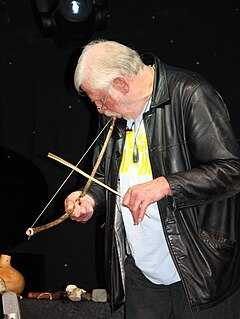
Bar zither is class of musical instruments within the Hornbostel-Sachs classification system for a type of simple chordophone, in which the body of the instrument is shaped like a bar.
The Uhadi musical bow is a traditional Southern African Xhosa musical instrument. It is a large unembraced musical bow which is attached to a resonator and played by percussion. The length of the string bow ranges from 115 to 130 centimeters. Similar musical bows in Southern Africa include the ‘’thomo’’ in Sotho music and the ‘’ugubhu’’ in Zulu music.

The eka-tantrī vīṇā was a medieval tube-zither veena in India, with a single string and one or more gourd resonators. The instrument became prominent in Indian music in about the 10th century C.E. as instruments of court music. Alongside the alapini vina and kinnari vina it replaced the harp-style veenas and lute-style veenas in sculpture. It was possibly a forerunner of the rudra vina. It shares its name with the modern single-string drone lute, the ektara.

The ālāpiṇī vīṇā was a medieval stick-zither veena in India, with a single string and a gourd resonator. Later forms added more strings. The instruments became prominent in Indian music after 500 C.E. as instruments of court music. Alongside the eka-tantri vina and kinnari vina it replaced the harp-style veenas and lute-style veenas. The instruments were used in Southeast Asia, both mainland and island nations, and were recorded in sculpture and relief sculpture.
References
- ↑ Simon Broughton; Mark Ellingham; Richard Trillo (1999). World Music: The Rough Guide . p. 671. ISBN 1-85828-635-2.